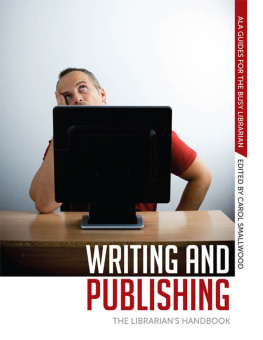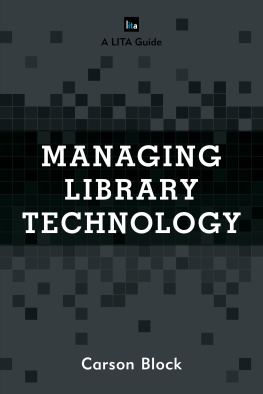Smallwood - Library Management Tips that Work
Here you can read online Smallwood - Library Management Tips that Work full text of the book (entire story) in english for free. Download pdf and epub, get meaning, cover and reviews about this ebook. City: Chicago, year: 2011, publisher: ALA Editions;American Library Association, genre: Home and family. Description of the work, (preface) as well as reviews are available. Best literature library LitArk.com created for fans of good reading and offers a wide selection of genres:
Romance novel
Science fiction
Adventure
Detective
Science
History
Home and family
Prose
Art
Politics
Computer
Non-fiction
Religion
Business
Children
Humor
Choose a favorite category and find really read worthwhile books. Enjoy immersion in the world of imagination, feel the emotions of the characters or learn something new for yourself, make an fascinating discovery.
- Book:Library Management Tips that Work
- Author:
- Publisher:ALA Editions;American Library Association
- Genre:
- Year:2011
- City:Chicago
- Rating:4 / 5
- Favourites:Add to favourites
- Your mark:
- 80
- 1
- 2
- 3
- 4
- 5
Library Management Tips that Work: summary, description and annotation
We offer to read an annotation, description, summary or preface (depends on what the author of the book "Library Management Tips that Work" wrote himself). If you haven't found the necessary information about the book — write in the comments, we will try to find it.
Library Management Tips that Work — read online for free the complete book (whole text) full work
Below is the text of the book, divided by pages. System saving the place of the last page read, allows you to conveniently read the book "Library Management Tips that Work" online for free, without having to search again every time where you left off. Put a bookmark, and you can go to the page where you finished reading at any time.
Font size:
Interval:
Bookmark:
LIBRARY MANAGEMENT TIPS THAT WORK
ALA EDITIONS PURCHASES FUND ADVOCACY, AWARENESS, AND ACCREDITATION PROGRAMS FOR LIBRARY PROFESSIONALS WORLDWIDE.
LIBRARY MANAGEMENT TIPS THAT WORK
CAROL SMALLWOOD, EDITOR
AMERICAN LIBRARY ASSOCIATION
CHICAGO 2011
Carol Smallwood received her MLS from Western Michigan University and her MA in history from Eastern Michigan University. Writing and Publishing: The Librarians Handbook and Librarians as Community Partners: An Outreach Handbook are 2010 ALA anthologies she has edited. Lilys Odyssey and Contemporary American Women: Our Defining Passages are new releases outside librarianship. Her magazine credits include The Writers Chronicle, English Journal, and Michigan Feminist Studies; her library experience covers work in school, public, academic, and special libraries as well as being an administrator and consultant. This is her twenty-fourth published book.
2011 by the American Library Association. Any claim of copyright is subject to applicable limitations and exceptions, such as rights of fair use and library copying pursuant to Sections 107 and 108 of the U.S. Copyright Act. No copyright is claimed in content that is in the public domain, such as works of the U.S. government.
While extensive effort has gone into ensuring the reliability of the information in this book, the publisher makes no warranty, express or implied, with respect to the material contained herein.
ISBNs: 978-0-8389-1121-1 (paper); 978-0-8389-9286-9 (PDF); 978-0-8389-9287-6 (ePub); 978-0-8389-9288-3 (Mobipocket); 978-0-8389-9289-0 (Kindle). For more information on digital formats, visit the ALA Store at www.alastore.ala.org and select eEditions.
Library of Congress Cataloging-in-Publication Data
Library management tips that work / Carol Smallwood, editor.
p. cm.
Includes bibliographical references and index.
ISBN 978-0-8389-1121-1 (alk. paper)
1. Library administrationHandbooks, manuals, etc. I. Smallwood, Carol, 1939
Z678.L4858 2011
025.1dc23
2011017081
Book design in Din and Electra by Casey Bayer.
Cover image Thomas M. Perkins/Shutterstock, Inc.
My thanks to Mary Lou Andrews for technical help online.
CONTENTS
FOREWORD
The diversity of topics covered in this book attests to the broad scope of responsibilities that managing libraries requires. Managers must prepare their buildings and staffs for disasters, set standards and enforce rules, and trust their staff members to have the judgment necessary to get the work done on a daily basis. One major theme of this book is that managers of libraries do so much more than approve payroll and build collections, especially when personnel is limited.
All of these aspects and more must be considered in order to operate a library with unique local circumstances while continuing to build rapport with the community. As Lynn Hawkins, executive director of Mentor (Ohio) Public Library writes, libraries and library managers have long arms that must embrace an even longer list of responsibilities. Different management styles are required for overall success, which is why supervisors should also be enablers. They should enable their librarys patrons to be proactive with their own needs, and they should enable their staff to reach out with their own powerful long arms to provide innovative and entrepreneurial means of assisting patrons.
The experiences of this volumes contributors are proven ways of achieving goals. Chapters discuss the all-important role of communication, how to work with boards, ways to capitalize on resources at hand such as volunteers, creating and fostering partnerships, and how to merge service pointswhich is more than a current trend; it is a new standard that libraries face because their budgets cannot support enough staff to maintain different service desks. Other chapters relate plans for engaging students and patrons, taking advantage of open-source information technology to assist with management goals, and coaxing still more work out of employees, along with even more best practices for handling public relations and marketing.
Although libraries are in the business of providing customers with information and services as a kind of product, business models do not speak to the intricacies involved with running a library. After reading this book, we see the nuances of models and segments of styles that library managers seem to adopt instinctively.
Among their many roles, libraries are community centers, gathering spaces, academic pivot points, harbors, workspaces, learning centers, computing centers, publicity firms, and technology hubs. That librarians become managers without the formal education of business majors speaks to the entrepreneurial, adaptive, motivated spirit of people who work in libraries. Librarians know that success is measured not by the value of stocks and bonds but by the quality of services provided and by the gratitude shown by patrons.
Management responsibilities often come to librarians in difficult times, as when budgets forbid new hires, when blended librarianship is the norm, when young librarians are thrust into leadership positions without the leisure of gaining experience by rising through the ranks, and when new generations of technology dictate a new paradigm for the administration and role of libraries. As long as anthologies such as this document how we accomplish our work in these changing times, people in management positions will be ready to meet the needs of communities.
Melissa J. Clapp, George A. Smathers Libraries, University of Florida
PREFACE
Library Management TIPS THAT WORK is an anthology for public, academic, special, and school librarians looking for successful examples of management when so much is changing in the profession: how to manage staff, time, boards, emergencies, finances, stress, patrons, technology, and related topics day after day with budget and staff cuts. It provides guidance on planning as well as execution. Managers are sometimes defined as those who bring out the best in others; in the library it is a term not limited to directors but includes youth services coordinators, reader advisors, web administrators, and circulation heads, any of whom could be in small rural libraries or large urban settings. This collection is for beginners as well as old hands, and for solo librarians and those part of a large staff. It includes chapters centered on practical results by librarians making hard choices to provide the best service, whether that be one of the librarys many specialized services or activities more commonly associated with library directors.
Management is central to good libraries, no matter the type of library or the librarians position title and roles, but it is largely learn-as-you-go, as expressed by the librarians who generously share their experiences in this volume. You may have had management classes, read books on management style, and attended workshops and webinars filled with well-designed organization charts, but these chapters will provide valuable insight on how influential managers really areand on what they can do to make that influence work for the library and its patrons.
For this collection, I sought chapters from practicing public, school, academic, and special librarians from different areas in the country. I asked contributors to write concise, how-to case studies of successful managers employing innovation. Some suggested topics in the call were staff flex hours, financial planning, administrative skills, public relations, time management, library boards, partnering, library manuals, professional ethics, innovative technology, handling employees, and volunteers.
It was my privilege to work with the librarians willing to share their experiences. These dedicated and creative professionals illustrate many facets of what makes an effective library managerwhat really works in these challenging times.
Font size:
Interval:
Bookmark:
Similar books «Library Management Tips that Work»
Look at similar books to Library Management Tips that Work. We have selected literature similar in name and meaning in the hope of providing readers with more options to find new, interesting, not yet read works.
Discussion, reviews of the book Library Management Tips that Work and just readers' own opinions. Leave your comments, write what you think about the work, its meaning or the main characters. Specify what exactly you liked and what you didn't like, and why you think so.











